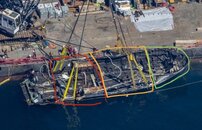george_austin
Contributor
- Messages
- 573
- Reaction score
- 289
- # of dives
- 5000 - ∞
QUOTED POST HAS BEEN DELETED BY MODERATOR
(Partial edit of post by moderator) I’ve charted Conception once and Vision I was a passenger on and I thought the fleet to be the best in the west. I saw no problems whatsoever and in a dive career spanning almost 5 decades, I’ve never heard anyone rag on Truth Aquatics fleet.
I’ve been a first responder in two fires at sea on a US Navy warship and preparedness and training is key - in every instance. A watch-stander is never assumed to be a less than vital resource whether it’s a main deck lookout while underway or a Boilerman of the Watch down in the fireroom.
(Partial edit of post by moderator) I’ve charted Conception once and Vision I was a passenger on and I thought the fleet to be the best in the west. I saw no problems whatsoever and in a dive career spanning almost 5 decades, I’ve never heard anyone rag on Truth Aquatics fleet.
I’ve been a first responder in two fires at sea on a US Navy warship and preparedness and training is key - in every instance. A watch-stander is never assumed to be a less than vital resource whether it’s a main deck lookout while underway or a Boilerman of the Watch down in the fireroom.





